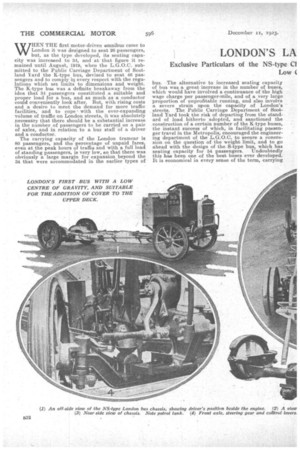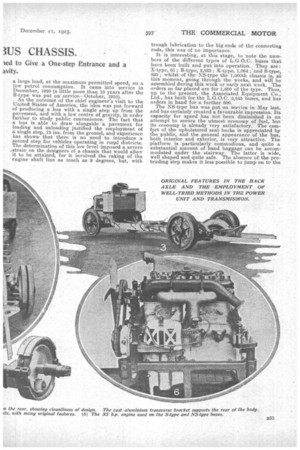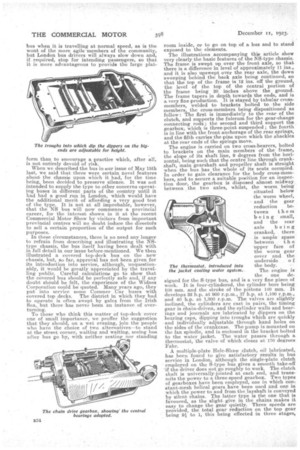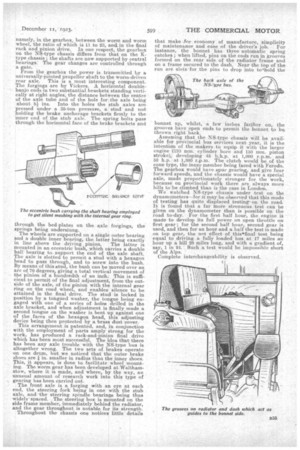• LONDON'S LA
Page 16

Page 17

Page 18

Page 19

If you've noticed an error in this article please click here to report it so we can fix it.
IUS CHASSIS. .
Exclusive Particulars of the NS-type Cl Low (
led to Give a One-step Entrance and a avity. WHEN THE first motor-driven omnibus came to London it was designed to seat 26 passengers, but, as the type developed, its seating capacity was increased to 34, and at that figure it remained until August, 1919, when the L.G.O.C. submitted to the Public Carriage Department of Scotland Yard the K-type bus, devised to seat 46 passengers and to comply in every respect with the regulations which set limits to dimensions and weight. The K-type bus was a definite breakaway from the idea that 34 passengers constituted a suitable and proper load for a bus, and as much as a conductor could conveniently look after. But, with rising costs and a desire to meet the demand for more traffic facilities, • and to cope • with the ever-expanding volume of traffic on London streets, it was absolutely necessary that there should be a substantial increase in the number of passengers to be carried on a pair of axles, and in relation to a bus staff of a, driver and a conductor.
The carrying capacity of the London tramear is SO passengers, and the percentage of unpaid fares, even at the peak hours of traffic and with a full load of standing passengers, is very low, so that there was obviously a large margin for expansion .beyond the 34 that were accommodated in the earlier types of
bus. The alternative to increased seating capacity of bus was a great increase in the number of buses, which would have involved a continuance of the high wage charge per passenger-mile, and of a very large proportion of unprofitable running, and also involve a severe strain upon the capacity of London's streets. The Public Carriage Department of Sootland Yard took the risk of departing horn the standard of load hitherto adopted, and sanctioned the construction of a certain number of the K-type buses, the instant success of which, in facilitating paesenger travel in the Metropolis, encouraged the engineering department of the L.G.O.C. to secure a concession on the question of the weight limit, and to go ahead with the design of the S-type bus which has seating capacity for 54 passengers. TJndoubtedly this has been one of the best buses ever developed. It is economical in every sense of the term, carrying a large load, at the maximum permitted speed, on a low petrol consumption. It came into service in December, 1920 (a little more than 10 years after the B-type was put on service—October, 1910).
As the outcome of the chief engineer's visit to the United States of America, the idea was put forward of producing a bus with a single step up from the pavement, and with a low centre of gravity, in order further to study public convenience. The fact that a bus is able to draw alongside a pavement for loading and unloading justified the employment a a single step, 13 ins, from the ground, and experience has shown that there is no need to introduce a second step for vehicles operating in rur,a1 districts. The determination of this low level imposed a severe ,strain on the designers of a chassis that would allow it to be attained, for it involved the raking of the engine shaft line as much as 9 degrees, but, with
trough lubrication to the big-ends of the connectina rods, this was of no importance.
It is interesting, at this stage, to note the numbers of the different types of L.G.O.C. buses that have been built and put into operation. They are : X-type, 61; B-type 2,825; K-type, 1,084 ;'and S-type, 895; whilst of the 'NS-type the 1,000th chassis is-, at this moment, going through the works, and will be assembled during this week or early next week. The orders so far placed are for 1,600 of the type. Thus, up to the present, the Associated Equipment Co., Ltd., has built for the L.G.O.C. 5,845 buses, and has orders in hand for a further 600.
The 'NS-type bus was put on serviee in May last, and has certainly created a favourable impression. Its capacity for speed has not been diminished in an attempt to secure the utmost economy of fuel, but its economy is already very satisfactory. The• comfort of the upholstered seat backs is appreciated by the public, and the general appearance of the bus, both interior and exterior, is very attractive. The platform -is particularly commodious, and quite a substantial amount of hand baggage can be accommodated under the stairway. 'The latter is wide, well shaped and quite safe. The absence of the protruding step makes it less possible to jump on to the bus when it is travelling at normal speed, as is the wont of the more agile members of the community, but London bus drivers will always slow down and, if required, stop for intending passengers, so that it is more advantageous to provide the large plat form than to encourage a practice which, after all, is not entirely devoid of risk.
When we described the bus in our issue of May 15th last, we said that there were certain novel features about the chassis upon which it had, for the time being, been decided to preserve silence. It was not intended to supply the type to other concerns operating buses in different parts of the country until it had had a good run in London, which would have the additional merit of affording a very good test of the type. It is not at all improbable, however, that the NS bus will now commence a provincial career, for the interest shown in it at the recent Commercial Motor Show by visitors from important provincial centres will no doubt induce the director's to sell a certain proportion of the output for such purposes.
, In these circumstances, there is no need any longer to refrain from describing and illustrating the NStype chassis, the bus itself having been dealt with in full detail in our issue before-mentioned. We then illustrated a covered top-deck bus on the new chassis, but, so far, approval has not been given for its introduction into service, although, unquestionably, it would be greatly appreciated by the travelling public. Careful calculations go to show that the covered bus should be perfectly safe and, if any doubt should be felt, the experience of the Widnes Corporation could be quoted. Many years ago, they put into service some Commer Car buses with covered top decks. The district in which they had to operate is often swept by gales from the Irish Sea, but there has never been an instance of overturning. To those who think this matter of top-deck cover one of small importance, we proffer the suggestion that they should, on a wet evening, join the people who have the choice of two alternatives—to stand at the street corner, waiting and waiting, seeing bus after bus go by, with neither seating nor standing
room inside' or to go on top of a bus and to stand exposed to the elements.
The illustrations accompanying this article show very clearly the basic features of the NS-type chassis. The frame is swept up over the front axle, so that there is a difference in level of approximately 11 ins., and it is also upswept over the rear axle, the down sweeping behind the back axle being continued, so that the top of the frame is 12 ins, off the ground, the level of the top of the central portion of the frame being 20 inches above the ground. The frame tapers in depth towards the ends, and is a very fine production. It is stayed by tubular crossmembers, welded to brackets bolted to the side members, the crosemembers being dispositioned as follow : The first is immediately to the rear of the clutch, and supports the fulcrum for the gear-change connecting rods ; the second and third support the gearbox, which is three-point suspended ; the fourth is in line with the front anchorage of the rear springs, and the fifth carries the pins upon which the shackles at the rear ends of the springs move. The engine is carried on two cross-bearers, bolted to brackets on the main members of the frame, the slope of its shaft line, 9 degrees from the horizontal, being such that the centre-line through crankshaft, main gearshaft and propeller shaft is straight when the bus has the whole of its seats occupied. In order to gain clearance for the body cross-members, and to secure a suitable position for an inspection door, the gearbox is disposed almost midway between the two axles, whilst, the worm being situated below the worm wheel, and the gear reduction between the m being small, and the rear axle being cranked, there is ,ample space between the upper face of the worm gear cover and the
underside o f the body.
The engine is the one designed for the S-type bus, and is a very fine piece of work. It is four-cylindered, the cylinder bore being 108 mm. and the stroke of the pistons 140 mm. It
develops 32 h.p. at 900 r.p.m.' 37 h.p. 1,100 and 40 h.p. at 1,300 r.p.m. The valves are slightly inclined, the cylinders are cast in pairs, the timing gear is chain-driven, and the cylinder walls and bearings and journals are lubricated by dippers on the bearing caps, "dipping into troughs which are quickly and individually adjustable through hand holes on the sides of the crankcase. The pump is mounted on
the fan spindle i
7 and is enclosed n the bracket bolted to the water jacket. The water passes through a thermostat, the valve of which closes at 170 degrees Fahr.
A multiple-plate Hele-Shaw clutch, oil lubricated, has been found to give satisfactory results in bus service in London, although the single-plate clutch employed on the S-type bus gives a smooth take-off if the driver does not go roughly to work. The clutch shaft is universally-jointed at each end, and transmits the power to a three-speed gearbox. Two types of gearboxes have been employee', one in which con-, stant-mesh helical gears have been used and one in which the power to and from the.layshaft is conveyed by silent chains. The latter type is the one that is favoured, as the slight give in the chains makes it easy to change the gear quietly. Three speeds are provided, the total gear reduction on the top gear being 91 to 1, this being effected in three stages,
namely, in the gearbox, between the worm and worm wheel, the ratio of which is 11 to 23, and. in the final rack and pinion drive. In one respect, the gearbox on the NS-type chassis differs from that on the Ktype chassis ; the shafts are now supported by central bearings: The gear changes are controlled through a fate. ', From the gearbox the power is transmitted by a universally-jointed propeller shaft to the worm-driven rear axle. This is a most interesting component. The forgings are by Vickers. A horizontal doublebanjo ends in two substantial brackets standing vertically at right angles, the distance 'between the centre of the axle tube and of the hole for the axle being about 51. ins. Into the holes the stub axles are pressed under a 35 ton pressure, a stud and nut holding the brake anchorage brackets firmly to the inner end of the stub axle. The spring bolts pass through the horizontal face of the brake brackets and
through the bed-plates on the axle forgings, the springs being underslung. The wheels are supported on a single outer bearing and a double inner bearing, the latter being exactly
in line above the driving pinion. The latter is mounted in an eccentric bush, which carries a double ball bearing to support the end of the axle shaft. The axle is slotted to permit a stud with a hexagon head to pass through, and to screw into the bush. By means of this stud, the bush can be moved over an arc of 70 degrees, giving a total vertical movement of the pinion of a hundredth of an inch. This is sufficient to permit of the final adjustment, from the outside of the axle, of the pinion with the internal gear ring on the road wheel, and enables silence to be attained in the final drive. The stud is locked in position by a tongued washer, the tongue being engaged with one of a series of• holes drilled in the axle bracket, and when adjustment is finally made a second tongue on the washer is bent up against one of the .faces of the hexagon head, this adjusting device being then protected by a brass dust cover.
This arrangement is patented, and, in conjunction with the employment of parts amply strong for the work, has produced a rack-and-pinion final drive which has been most successful. The idea tind there has been any axle trouble with the NS-type bus is altogether wrong. The two sets of brakes operate on one drum, but we noticed that the outer brake shoes are 1 in. smaller in radius than the inner shoes. This, it appears, is done to facilitate wheel mounting. The worm gear has been developed at Walthamstow, where it is made, and where, by the way, an unusual amount of research work into this type of gearing has been carried out
The front axle is a forging with an eye at each end, the steering fork being in one with the stub axle, and • the steering spindle bearings being thus widely-spaced. . The steering box is mounted on the side frame member, immediately behind the radiator, and the gear throughout is notable for its strength.
Throughout the chassis one notices little details
that make .for economy of manufacture, simplicity of maintenance and ease of the driver's job. For instance, the bonnet has three automaticcatches ; when lifted, pins on the ends run in grooves formed on the rear side of the radiator frame and on a frame secured to the dash. Near the top of the run are slots •• for the pins to drop into tolhold the
bonnet up, whilst, a few inches farther on, the grooves have open ends to permit the bonnet to 134 thrown right back.
Assuming that the NS-type chassis will be available for provincial bus services next year, it is the intention of the makers to equip it with the larger engine (120 mm. cylinder bore and 150 mm. piston stroke), developing 45 b.h.p. at 1,000 r.p.m. and 50 h.p. at 1,300 r.p.m. The clutch would be of the cone type, the inner member being faced with Ferodo. The gearbox would have spur gearing, and give four forward speeds, and the chassis would have a special axle, made proportionately stronger for the work, because on provincial work there are always more hills to be climbed than is the case in tondon.
We watched NS-type chassis under test on the dynamometers—for it may be observed that this mode of testing has quite displaced testing on the road. It is found that a far more strenuous test can be given on the dynamometer than is possible on the road to-day. Ii or the first half hour, the engine is made to develop its full power on open throttle on first gear ; for the second half hour' second gear. is used and then for an hour and a half the test is made on top gear, the net 'effect of thissfinal test being equal to driving a fully loaded bus at 17 miles an hour up a hill 28 miles long, and with a gradient of, say, 1 in 24. Such a test would be impossible short of the Alps.
Complete interchangeability is observed.
































